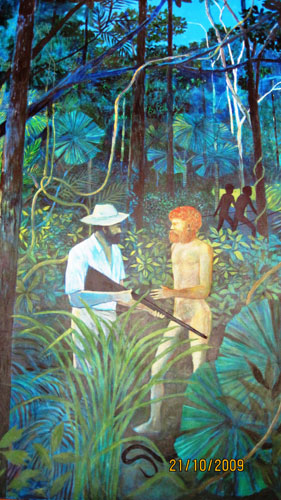A painting at Thala has caused many questions as to its meaning. History writes that G.E Dalrymple was the first white man to land on the shores at Kewarra Beach, Tropical North Queensland, Australia. However this painting by Ray Crooke tells a different story.

At the beginning of September 1873, G. Elphinstone Dalrymple received orders from the Colonial Secretary to take command of The Queensland North East Coast Expedition; the purpose of which was to explore the unknown territory between Cardwell and Cooktown, to report on the resources of the region and its suitability for settlement.
On Monday 29 September, the expedition set sail Northwards from Cardwell. Dalrymple’s expedition landed at Kewarra Beach and noticed “ in every camp along the beach for two miles unmistakable evidence of wholesale habitual cannibalism: heaps of human bones and skulls were found in each camp, and in some, roasted and partially eaten bodies were discovered beside the fires at which they had been cooked. Lumps of half eaten human flesh were found in the gins dilly bags”.
There is a great irony in Dalrymple’s speculation on the possible fate of a “poor shipwrecked crew cast ashore from the Pacific Ocean” . Unbeknown to him there were already five wild white men living with the tribesmen in this area.
Robert Johnstone himself wrote in his own journal: “I may here remark that the following morning I ran the tracks of the blacks, and found they had removed the bodies of those shot, and had a cannibal feast on them, and had stripped the others of the flesh and carried it away; and while we were camped at a lagoon getting a drink one of my troops happened to go to the top of the ridge, and found a large mob stalking us. I gave orders to pretend not to know, and we went on getting lily roots, but with rifles loaded and at full cock waiting for developments. We had not long to do so, as shortly after I saw a black head peering over the crest of the ridge, and others showing up. We gave them a volley and they did not wait for more, but they evidently did not intend us to invade their country without fighting. I regretted much they would not fraternize, as my leader’s orders were to use every endeavour to do so, and never to shoot unless compelled to do it in self defence; in fact, on several occasions I risked the safety of members of the party through carrying out his instructions too implicity. On one occasion our leader was so intent in examining the rocks in a creek near the camp that he would have been speared had not one of the troopers (who was yam hunting) been alert and shot the blackfellow within fifty yards of Mr Dalrymple, whom he was quietly stalking. There is no doubt he would have succeeded had it not been for the alertness of the trooper”.
In 1876 gold was discovered in the Hodgkinson region (inland from Kewarra). Access to the Hodgkinson was by a rough bush track over the range behind Kewarra Beach. After the discovery, the government spent 72 pounds upgrading the track, however, it later became impassable due to the presence of ‘poison bush’ which killed travelling stock.
The first bushmen to cut the track were amazed to see letters carved on trees, some of which had been freshly felled with axes; believing that they were the first white people into the area.
In September 1877, a bushman who had set up camp near the track awoke to find his horses had strayed in the night. While searching through the tall grass he disturbed and shot at a large black snake where upon to his utter surprise, the grass around him erupted with Indigenous Australians, all of whom ran off as fast as possible.
Amazingly a half caste boy jumped out of the grass and ran away. The bushman called out and pointed his rifle at the retreating figure at which point, “ a naked, dirty, greased white man with a red beard stood up and politely asked him not to shoot”.
This man explained how he had four companions, one of whom was the Father of the teenage half caste boy, and that they had been living with the Aboriginals for 14 years. This indicates that white men arrived 10 years before Dalrymple’s men landed on the coast near Kewarra.
The mystery of who they were and where they came from was never solved. The only two clues to their identity were that they were carrying American made axes and there were the remains of a shipwreck at White Cliffs (where Thala Beach Lodge sits today) twenty kilometers north of Kewarra.
